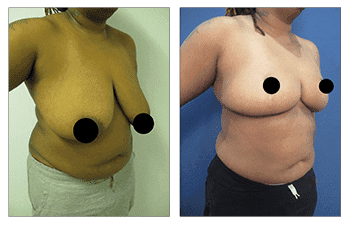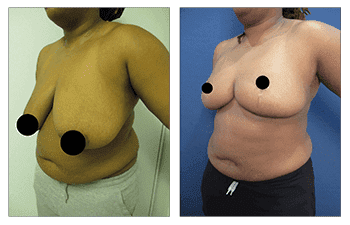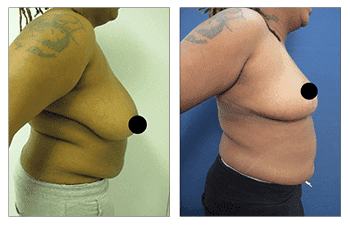



Please see a 35-year-old female patient who shows how best breast reduction can improve bilateral symptomatic breast hypertrophy and ptosis grade III.

Introduction: Best Breast Reduction
Breast reduction in general is performed to reduce the weight of breast tissues that can pull on your upper back and neck. However, these functional considerations should not neglect aesthetic priorities. As a result, breast reduction is achieved by utilizing optimal incision designs that take into consideration each patient’s required breast tissue elimination needs.
As such, patients must undergo a comprehensive evaluation to determine where their individual breast fullness and drooping are located. The reduction is achieved then by customizing the incision lines to address all of the problem spots with regards to the extent of redundant skin, areas of breast prominences with regards to glandular tissues and fat, and degree of sagging.
The best breast reduction surgery requires the use of an incision pattern described as the Weiss pattern. The Weiss pattern utilizes incision lines that allow for the preservation of blood supply to the nipple and areola complex while allowing for the removal of undesirable medial and lateral breasts. The tissue excess that is undesirable is mostly located over the lateral breast areas rather than the medial breast. When breast reduction is performed appropriately, it should result in not only the elimination of unwanted breast tissue mass but also a beautiful contour line that is rounded in appearance and aesthetically pleasing.
Best breast reduction surgery requires the creation of breasts that are both functionally improved by eliminating tension on your neck but also creating breasts that are youthful in appearance. A youthful-appearing breast will demonstrate appropriately positioned nipples and areolas as well as breast mounds that are aesthetically pleasing visually. Let us discuss details of breast reduction.
What is a Breast Reduction?
A breast reduction, also known as reduction mammoplasty, is a surgical procedure aimed at reducing the size and weight of the breasts. It is typically performed under general anesthesia and involves removing excess breast tissue, fat, and skin to achieve a more proportionate and comfortable breast size. Women may seek this procedure to alleviate physical discomfort such as back, neck, and shoulder pain, as well as skin irritation and posture issues caused by overly large breasts. It can also address self-esteem and body image concerns related to having disproportionately large breasts.
The benefits of breast reduction surgery include improved physical comfort and mobility, relief from chronic pain, better posture, and an overall enhanced quality of life. Aesthetic improvements may also result, leading to a more balanced and proportionate appearance. Additionally, the procedure can address specific problems such as difficulty finding well-fitting clothing, participating in physical activities, and maintaining a healthy body weight. Overall, breast reduction surgery can provide both physical and aesthetic improvements, making it a popular choice for women seeking relief from the discomfort and limitations associated with large, heavy breasts.
Benefits of Breast Reduction Surgery
Breast reduction surgery offers a range of potential benefits that can greatly improve a person’s quality of life. One of the most significant advantages is the reduction of back, neck, and shoulder pain, as well as improved posture. By alleviating the physical discomfort caused by large breasts, individuals can experience relief from irritation and discomfort, leading to an overall improvement in their quality of life.
Furthermore, breast reduction surgery allows for access to a wider range of bra and clothing options, as well as a boost in self-esteem and self-image. These benefits can positively impact physical activities, with individuals feeling more comfortable and confident in their movement. Clothes also fit more comfortably, and achieving an ideal silhouette becomes more attainable after the surgery.
Ultimately, breast reduction surgery not only addresses physical discomfort but also enhances overall well-being by improving body image and everyday comfort. Overall, the potential benefits of breast reduction surgery extend beyond physical relief, providing a positive impact on one’s mental and emotional well-being.
Ideal Breast Reduction Candidates
Ideal candidates for breast reduction surgery are those who experience significant physical discomfort, such as chronic back, neck, and shoulder pain caused by the weight of their large breasts. They may also suffer from skin irritation, bra strap indentations, and difficulty finding clothes that fit properly. Furthermore, emotional distress related to body image, self-esteem, and social interactions due to large breasts, as well as interference with daily activities such as exercising or maintaining an active lifestyle, are key factors that make someone an ideal candidate for breast reduction surgery.
It is important for candidates to be mentally stable and emotionally prepared for the surgery, with realistic expectations and specific goals in mind for the outcome. They should also be physically healthy, with no underlying medical conditions that could increase the risks associated with the procedure and recovery. Overall, a thorough evaluation by a qualified plastic surgeon is essential to determine if an individual is a suitable candidate for breast reduction surgery based on these characteristics and criteria.
What to Expect From Your Breast Reduction Procedure
Breast reduction surgery, also known as reduction mammoplasty, typically involves the use of general anesthesia to ensure the patient is comfortable and pain-free throughout the procedure. There are several incision options, including the anchor, vertical, and periareolar, depending on the amount of tissue that needs to be removed and the desired outcome. The surgeon will meticulously remove excess breast tissue, fat, and skin to achieve the desired size and shape.
Following the procedure, patients will be closely monitored and may be required to stay overnight for observation. Post-operative care will include wearing a surgical bra for support, managing pain and discomfort with prescribed medication, and avoiding strenuous activities for a few weeks. Scarring is a common issue, and although efforts are made to minimize scarring, it is a natural part of the healing process. The expected recovery time varies, but patients can generally return to work within 1-2 weeks and resume normal activities within 4-6 weeks.
It’s important to consult with a board-certified plastic surgeon to discuss the specific details of the procedure and ensure realistic expectations for the outcome.
Breast Reduction Recovery and Results
Breast reduction surgery, also known as reduction mammoplasty, involves the removal of excess breast tissue to achieve a smaller, more proportionate breast size. After the procedure, patients can expect some discomfort and swelling, which can be managed with prescribed pain medication and ice packs. Post-operative care instructions typically include keeping the surgical area clean and dry, avoiding strenuous activities or heavy lifting, and wearing a specialized surgical bra for proper support and comfort.
In some cases, surgical drains may be necessary to remove excess fluid and reduce the risk of complications. Long-acting local anesthetic may also be administered to help manage post-operative pain.
The recovery timeline for breast reduction surgery varies, but typically, stitches are removed within 1-2 weeks, and patients can transition to wearing a regular bra after 4-6 weeks. Normal activities, including exercise, can usually be resumed within 6-8 weeks.
The expected results of breast reduction surgery include a more proportionate and comfortable breast size, improved posture, and relief from physical symptoms such as back, neck, and shoulder pain. Overall, patients can expect improved self-confidence and quality of life after undergoing breast reduction surgery.
Is Breast Reduction Surgery Covered by Insurance?
Many insurance companies cover breast reduction surgery if it meets specific criteria. The surgery must be considered medically necessary, meaning the patient experiences physical symptoms such as neck, back, or shoulder pain, skin irritation, or difficulty with physical activity due to the size of their breasts. Alternative treatments, such as physical therapy or pain management, may also need to be pursued before insurance will cover the surgery. Additionally, insurance companies may evaluate the patient’s breast size in relation to their body mass index (BMI) and body surface index (BSI) to determine if the surgery is medically necessary. It’s important to note that insurance typically does not cover aesthetic breast reduction surgery, only medically necessary procedures.
Patients considering breast reduction surgery should contact their insurance provider to confirm their medical benefits and requirements for coverage. This will help ensure that they understand what steps need to be taken and what documentation is required to seek insurance coverage for the procedure.
Conclusion: Best Breast Reduction
The best breast reduction surgery procedure involves removing excess breast tissue to achieve a more proportionate and comfortable breast size. The recovery process typically involves wearing a special surgical bra, limiting physical activity, and managing any discomfort with pain medication. Patients can expect to see improved breast shape and size, reduced back and neck pain, and an overall boost in self-confidence and quality of life.
Following post-operative instructions is crucial for a successful recovery. Patients should adhere to restrictions on physical activities, keep the surgical site clean and dry, and attend all follow-up appointments with their surgeon. The care team plays a vital role in monitoring the healing process and addressing any concerns that may arise.
Key factors to consider before undergoing breast reduction surgery include physical discomfort, such as neck and back pain, self-consciousness, difficulty finding clothing that fits well, and an overall decrease in quality of life. By addressing these factors, patients can experience a positive impact on their physical and emotional well-being. Ultimately, the decision to undergo breast reduction surgery is a personal one and should be carefully considered with the guidance of a qualified surgeon.
If you are having upper back and neck pain because of your sagging and enlarged breasts and are considering a breast reduction surgery, we encourage you to take advantage of SurgiSculpt’s expertise so that you can get this procedure done in an aesthetically pleasing manner.
